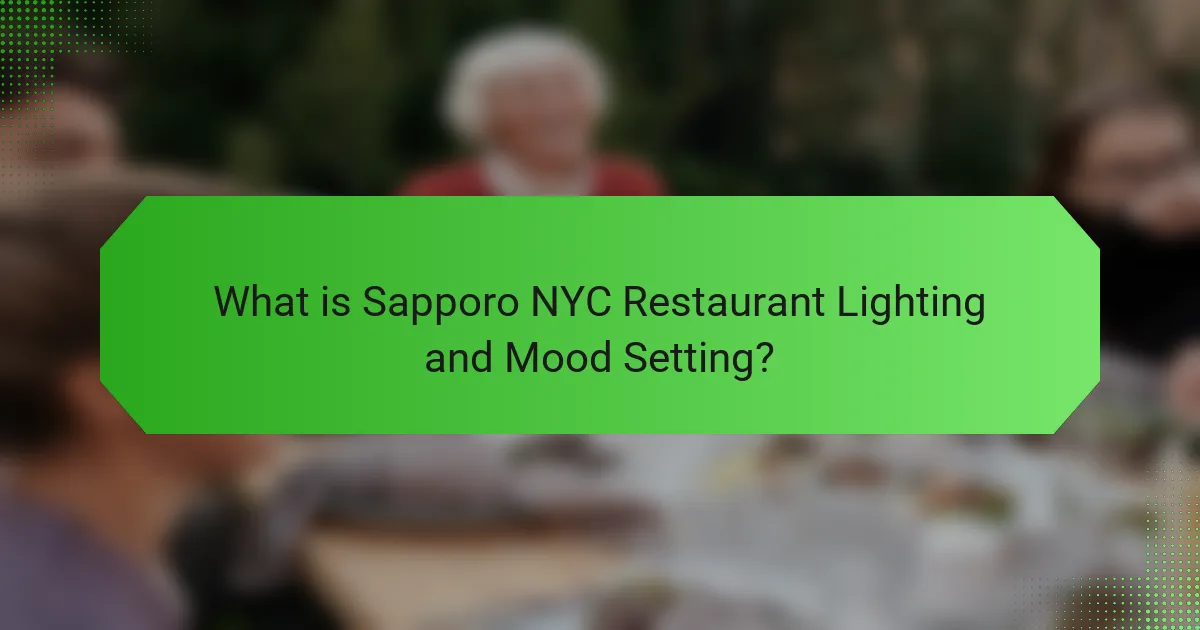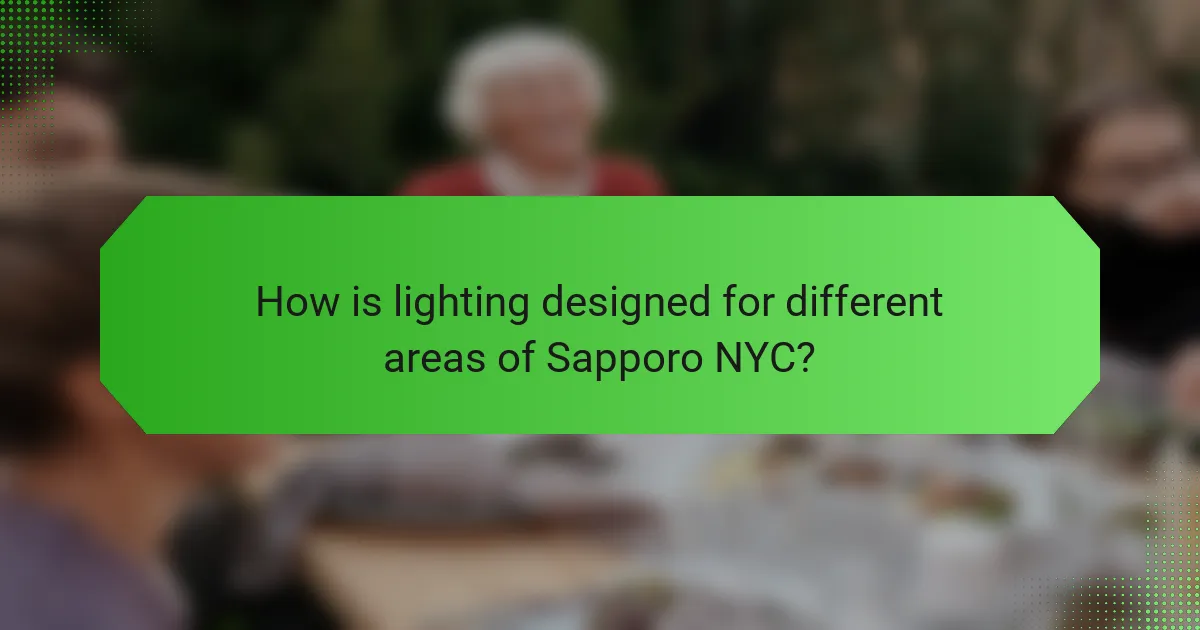
What is Sapporo NYC Restaurant Lighting and Mood Setting?
Sapporo NYC Restaurant Lighting and Mood Setting refers to the strategic use of lighting to create a specific atmosphere in the restaurant. This lighting design enhances the dining experience by influencing customers’ emotions and perceptions. Sapporo NYC employs various lighting techniques, such as ambient, task, and accent lighting, to achieve the desired mood. For instance, dim lighting can create an intimate setting, while brighter lights may foster a more energetic atmosphere. Studies indicate that lighting can affect appetite and behavior, making it a crucial element in restaurant design. Effective lighting can lead to increased customer satisfaction and longer dining durations.
How does lighting influence the dining experience at Sapporo NYC?
Lighting at Sapporo NYC significantly enhances the dining experience by creating an inviting atmosphere. The restaurant employs warm, ambient lighting to foster a relaxed and comfortable environment. This type of lighting encourages social interaction among diners. Dimmed lights during evening hours promote intimacy, making it suitable for romantic dinners. The strategic use of spotlights highlights specific dishes, drawing attention to their presentation. Research indicates that lighting can affect appetite and food perception. A study published in the Journal of Consumer Research found that softer lighting can lead to increased enjoyment of meals. Overall, lighting at Sapporo NYC plays a crucial role in setting the mood and enhancing the overall dining experience.
What types of lighting are used in Sapporo NYC Restaurant?
Sapporo NYC Restaurant uses ambient, task, and accent lighting. Ambient lighting provides general illumination throughout the space. Task lighting is focused on specific areas for practical purposes, such as dining tables. Accent lighting highlights decor and architectural features. These lighting types create a warm and inviting atmosphere. The combination enhances the overall dining experience.
How does the choice of lighting color affect mood?
The choice of lighting color significantly affects mood. Different colors evoke distinct emotional responses. Warm colors, like red and yellow, can create feelings of warmth and comfort. They often stimulate conversation and appetite. Cool colors, such as blue and green, tend to have calming effects. These colors can promote relaxation and tranquility. Research shows that blue light can enhance focus and productivity. In contrast, harsh white light can induce stress and discomfort. Studies indicate that lighting color influences physiological responses, such as heart rate and hormone levels. Therefore, selecting appropriate lighting colors is crucial for setting the desired mood in environments like restaurants.
What role does mood setting play in customer satisfaction?
Mood setting significantly influences customer satisfaction in dining experiences. The ambiance created by lighting, music, and decor affects customers’ emotions and perceptions. Positive mood settings can enhance enjoyment and comfort during meals. Studies show that well-designed environments lead to higher satisfaction ratings. For instance, a study published in the Journal of Consumer Research found that ambient lighting impacts diners’ mood and food enjoyment. This correlation highlights the importance of mood setting in restaurants like Sapporo NYC. Effective mood setting can result in repeat visits and positive word-of-mouth.
How can ambiance enhance the overall dining experience?
Ambiance enhances the overall dining experience by creating a specific atmosphere that influences diners’ emotions and perceptions. The right lighting can make food appear more appetizing. For example, warm lighting often makes a space feel cozy and inviting. This can encourage longer stays and increased customer satisfaction. Music also plays a crucial role in setting the mood. Studies show that background music can affect the pace of eating and overall enjoyment. Additionally, decor elements contribute to the ambiance. A well-designed space can evoke feelings of luxury or comfort. Research indicates that aesthetically pleasing environments can enhance the perceived quality of food. Overall, ambiance is a key factor in shaping memorable dining experiences.
What psychological effects does lighting have on diners?
Lighting significantly influences the psychological state of diners. It affects mood, behavior, and overall dining experience. Bright lighting can create an energetic atmosphere, encouraging social interaction and faster dining. Conversely, dim lighting promotes relaxation and intimacy, often leading to longer meal durations. Research indicates that warm light enhances comfort and satisfaction, while cool light can increase alertness. A study published in the Journal of Consumer Research found that ambient light levels directly impact food enjoyment. Therefore, the choice of lighting is crucial in shaping diners’ perceptions and experiences in a restaurant setting.

How is lighting designed for different areas of Sapporo NYC?
Lighting in Sapporo NYC is designed to create distinct atmospheres for various areas. The design incorporates a mix of ambient, task, and accent lighting. Ambient lighting provides overall illumination, ensuring comfort and visibility. Task lighting focuses on specific areas for activities like dining or reading menus. Accent lighting highlights architectural features and decor, enhancing visual interest.
Different sections, such as dining areas and bars, utilize unique lighting schemes. For example, dining spaces often feature softer, warmer lights to foster intimacy. In contrast, bar areas may use brighter, more dynamic lights to energize the environment.
The design also considers the time of day and seasonal changes. Adjustments are made to complement natural light and create a welcoming atmosphere. Overall, the lighting design in Sapporo NYC aims to enhance the dining experience and reflect the restaurant’s theme.
What specific lighting techniques are employed in the dining area?
The dining area employs ambient, task, and accent lighting techniques. Ambient lighting provides overall illumination, creating a warm atmosphere. This is typically achieved through ceiling fixtures and wall sconces. Task lighting focuses on specific areas, such as tables, often using pendant lights or spotlights. Accent lighting highlights decor elements, enhancing visual interest. This is accomplished with strategically placed LED lights or wall-mounted fixtures. These techniques work together to create a balanced and inviting dining experience.
How does the lighting design change between casual and formal dining spaces?
Lighting design in casual dining spaces is typically bright and inviting. It aims to create a relaxed atmosphere. Common fixtures include pendant lights and recessed lighting. These designs facilitate social interaction and comfort.
In contrast, formal dining spaces utilize softer, dimmer lighting. This approach enhances elegance and intimacy. Chandeliers and wall sconces are often used to create a sophisticated ambiance. The lighting is strategically placed to highlight table settings and decor.
The difference in lighting design reflects the intended dining experience. Casual spaces encourage a lively, informal vibe. Formal spaces prioritize a refined, serene environment. This distinction influences customer behavior and overall satisfaction.
What factors influence the brightness levels in various sections?
Brightness levels in various sections are influenced by multiple factors. These factors include the type of light sources used, such as LED or incandescent bulbs. The placement of lights also plays a critical role in determining brightness. Additionally, the color temperature of the lights affects perceived brightness levels. Reflective surfaces in the environment can enhance or diminish light intensity. The overall design and layout of the space contribute to how light is distributed. Finally, the time of day and natural light availability can significantly alter brightness levels in different sections.
How does outdoor lighting contribute to the restaurant’s atmosphere?
Outdoor lighting significantly enhances a restaurant’s atmosphere by creating an inviting and warm environment. It sets the mood for diners, influencing their overall experience. Well-placed lighting can highlight architectural features and outdoor seating areas. Soft, ambient lighting encourages relaxation and social interaction. Bright lighting may be used to energize the space during busy hours. According to a study by the Journal of Environmental Psychology, lighting affects emotional responses and can enhance dining satisfaction. Proper outdoor lighting also increases visibility, ensuring safety and comfort for guests. Thus, outdoor lighting is crucial in shaping a restaurant’s unique ambiance.
What are the key considerations for outdoor lighting design?
Key considerations for outdoor lighting design include functionality, safety, aesthetics, and energy efficiency. Functionality ensures that the lighting serves its purpose, such as illuminating pathways and dining areas. Safety is crucial to prevent accidents and enhance visibility at night. Aesthetics contribute to the overall ambiance and mood of the space, which is particularly important for restaurants. Energy efficiency helps reduce operational costs and environmental impact. Additionally, the choice of fixtures and the color temperature of the lights can significantly affect the atmosphere. Proper placement and intensity of lights also play a vital role in achieving the desired effect.
How does seasonal variation affect outdoor lighting choices?
Seasonal variation significantly influences outdoor lighting choices. In winter, shorter days and longer nights necessitate brighter, warmer lighting to create a cozy atmosphere. Restaurants often opt for string lights and lanterns to enhance the inviting feel during colder months. In contrast, summer brings longer daylight hours, allowing for softer, ambient lighting options. Outdoor dining spaces may utilize dimmable fixtures and candles to foster a relaxed environment. Research shows that lighting impacts customer mood and behavior. A study published in the Journal of Environmental Psychology found that warm lighting increases comfort and encourages longer stays in dining establishments. Therefore, adapting outdoor lighting to seasonal changes enhances the overall dining experience.

What are the best practices for achieving optimal lighting in Sapporo NYC?
To achieve optimal lighting in Sapporo NYC, utilize a combination of natural and artificial light sources. Incorporate dimmable LED fixtures to adjust brightness levels throughout the day. Use warm color temperatures between 2700K and 3000K to create a cozy atmosphere. Position lights to highlight key areas, such as dining tables and artwork. Utilize pendant lighting over tables for focused illumination. Implement task lighting for staff areas to enhance functionality. Consider using light-dimming controls for flexibility during different dining experiences. Studies show that well-designed lighting increases customer satisfaction and dwell time in restaurants.
How can restaurant owners balance functionality and aesthetics in lighting?
Restaurant owners can balance functionality and aesthetics in lighting by using a layered lighting approach. This involves combining ambient, task, and accent lighting. Ambient lighting provides overall illumination, ensuring visibility and comfort. Task lighting focuses on specific areas, like tables and kitchens, enhancing functionality. Accent lighting highlights architectural features or decor, adding visual interest.
Using dimmable fixtures allows flexibility to adjust lighting for different times of day or events. Selecting fixtures that complement the restaurant’s theme enhances aesthetics while maintaining functionality. For instance, pendant lights can serve both purposes effectively.
Research indicates that proper lighting can influence customer mood and dining experience. A study by the Journal of Environmental Psychology found that softer lighting increases relaxation and encourages longer visits. Therefore, balancing these elements can enhance the overall dining atmosphere.
What tools and technologies are available for effective lighting management?
Effective lighting management tools and technologies include smart lighting systems, dimmers, and control software. Smart lighting systems allow for remote management and automation of lighting settings. Dimmers provide adjustable brightness levels for different moods and times of day. Control software enables centralized management of lighting across multiple areas. Additionally, occupancy sensors can optimize energy use by adjusting lighting based on presence. These technologies enhance ambiance and improve energy efficiency. For instance, smart systems can reduce energy consumption by up to 30% when programmed efficiently.
How can staff training improve the implementation of lighting strategies?
Staff training can significantly enhance the implementation of lighting strategies in restaurants. Trained staff can better understand the importance of lighting in creating ambiance. They can adjust lighting settings according to customer preferences and dining experiences. Knowledgeable employees will recognize the effects of different lighting on mood and behavior. Training can include practical demonstrations on lighting controls and placements. This ensures consistent application of lighting strategies across shifts. Additionally, well-trained staff can provide feedback on lighting effectiveness, leading to continuous improvement. Studies show that effective training correlates with increased customer satisfaction and repeat business.
What tips can enhance mood setting through lighting at Sapporo NYC?
Adjusting the lighting can significantly enhance mood at Sapporo NYC. Use dimmable lights to create a cozy atmosphere. Warm color temperatures, around 2700K to 3000K, promote relaxation. Incorporate accent lighting to highlight specific areas or decor. Utilize candles or soft table lamps for intimate settings. Layering different light sources adds depth and interest. Consider the time of day; natural light can uplift mood during lunch hours. Control light intensity to match the dining experience, transitioning to softer lights during dinner. These strategies contribute to a welcoming environment, enhancing overall guest satisfaction.
How can adjustable lighting improve customer experiences during different times of day?
Adjustable lighting can significantly enhance customer experiences by creating a suitable atmosphere for different times of day. During breakfast hours, bright lighting can energize and stimulate appetite. As the day progresses, softer lighting can promote relaxation and comfort, encouraging customers to linger.
In the evening, dimmed lighting can create an intimate ambiance, ideal for dining. Research shows that appropriate lighting can influence mood and satisfaction levels in restaurants. A study published in the Journal of Environmental Psychology found that customers reported higher satisfaction with their dining experience when lighting was adjusted to match the time of day.
This adaptability in lighting not only caters to the natural circadian rhythms of customers but also aligns with their emotional needs throughout their visit. Thus, adjustable lighting plays a crucial role in enhancing overall customer satisfaction in a restaurant setting.
What common lighting mistakes should be avoided in restaurant settings?
Common lighting mistakes to avoid in restaurant settings include using overly bright or harsh lighting. This can create an uncomfortable atmosphere for diners. Insufficient lighting is another mistake, leading to difficulty in reading menus and navigating the space. Inappropriate color temperature can affect the mood; for example, overly cool lighting may feel uninviting. Failing to consider the layout can result in uneven lighting, leaving some areas too dim. Neglecting to adjust lighting for different times of day can impact the dining experience. Lastly, not using dimmers can limit flexibility in ambiance. Each of these mistakes can detract from the overall dining experience.
Sapporo NYC Restaurant Lighting and Mood Setting refers to the strategic use of lighting to create a specific atmosphere that enhances the dining experience by influencing emotions and perceptions. The article explores various lighting techniques, including ambient, task, and accent lighting, and their effects on customer satisfaction, appetite, and overall mood. It examines the role of lighting design in different areas of the restaurant, the psychological impact of lighting color, and best practices for achieving optimal lighting. Additionally, the article highlights the importance of adjustable lighting and staff training in improving customer experiences and avoiding common lighting mistakes.


